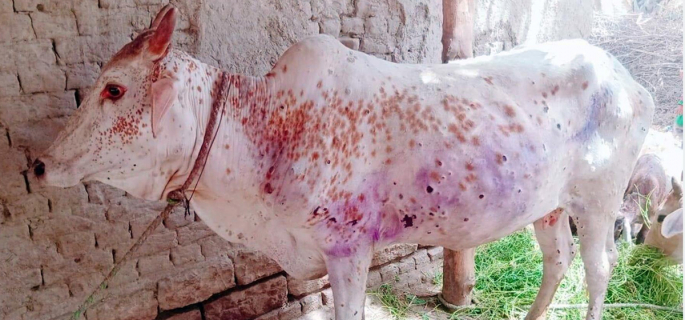
OR
#Editorial
Take necessary measures to tackle lumpy skin disease
Published On: July 9, 2023 07:30 AM NPT By: Republica | @RepublicaNepal

The lumpy skin disease has emerged as a grave threat to the livestock industry, causing significant economic losses and posing a serious risk to animal health in Nepal. The recent outbreak of this viral disease has reached alarming proportions, resulting in the unfortunate demise of thousands of cattle in different parts of the country. This calls for urgent measures by the government and other stakeholders to contain the spread of lumpy skin disease and safeguard the livelihoods of farmers who rely on livestock for their sustenance. The Department of Livestock Services (DoHS) has rightly called upon local government bodies concerned to be proactive in combating this epidemic. It is imperative that these authorities take immediate action by acquiring medicines and vaccines to effectively tackle the disease. While the DoHS has already provided financial assistance to the affected regions, additional support is necessary to prevent further loss of livestock.
The statistics provided by the DoHS paint a grim picture of the situation. With over 25,000 cattle deaths and more than 229,000 active cases reported, the lumpy skin disease has rapidly spread across 76 districts since its initial outbreak. This epidemic not only threatens the health and lives of animals but also jeopardizes the economic stability of countless farmers who rely on cattle for their livelihoods. The lumpy skin disease is caused by the capripox virus and is primarily transmitted by biting insects such as mosquitoes, flies, and ticks. The symptoms include fever, skin eruptions, excessive salivation, and the formation of nodules on the skin. In severe cases, the disease can prove fatal, especially for animals that have not been previously exposed to the virus. Control options for the lumpy skin disease include vaccinations and culling of infected animals. It is, therefore, high time the government took a comprehensive approach to effectively control and prevent the spread of the lumpy skin disease.
The government, in collaboration with the Department of Livestock Services and other stakeholders, must focus on various measures, including enhanced vaccination programs, movement control and quarantine, public awareness and education, research and development, and collaborative efforts. Vaccination is the most effective means to control the disease and the government should prioritize this effort. The government should ensure the availability of sufficient vaccines and make them accessible to the farmers in affected areas. Similarly, strict movement control measures should be implemented to prevent the spread of the disease in the unaffected areas. Quarantine protocols must be established and enforced to minimize the risk of transmission. An informed and educated community plays a crucial role in disease control. The government should launch public awareness campaigns to educate livestock owners about the symptoms, prevention, and control measures for the lumpy skin disease. Continuous research and development efforts are vital to improving our understanding of the lumpy skin disease and developing more effective vaccines and treatments. The government should allocate resources for research initiatives in collaboration with veterinary institutions and other relevant bodies. Above all, it is equally important to ensure that government agencies, veterinary professionals, farmers' associations, and international organizations work together in a coordinated manner to combat the lumpy skin disease. Sharing knowledge, resources, and best practices will strengthen our collective response.
Experiences in other parts of the world suggest that the lumpy skin disease poses a severe threat to the livestock industry, farmers' livelihoods, and food security. Immediate and concerted action is essential to contain the spread of the disease, protect animal health and welfare, and mitigate economic losses. As a newspaper, we urge the government to lead the charge by allocating adequate funds, coordinating efforts among relevant stakeholders, and implementing comprehensive control strategies. It is our collective responsibility to safeguard the well-being of our livestock and support the farmers who depend on them. Let us act swiftly and decisively to combat the lumpy skin disease and secure a prosperous future for our agricultural sector.
You May Like This

Lumpy skin disease under control: Minister Dr Bhusal
KATHMANDU, Sept 4: Minister for Agriculture and Livestock, Dr Beduram Bhusal, has said lumpy skin disease had come under control. Read More...

Lawmakers draw government's attention on urgency to control lumpy skin disease
KATHMANDU, July 14: Lawmakers have drawn the attention of the government on various contemporary issues including lumpy skin disease. ... Read More...

Lumpy skin disease goes out of control in Baitadi
BAITADI, July 11: Rapid spread of lumpy skin disease has taken a heavy toll on livestock in Baitadi district. ... Read More...











Just In
- Challenges Confronting the New Coalition
- NRB introduces cautiously flexible measures to address ongoing slowdown in various economic sectors
- Forced Covid-19 cremations: is it too late for redemption?
- NRB to provide collateral-free loans to foreign employment seekers
- NEB to publish Grade 12 results next week
- Body handover begins; Relatives remain dissatisfied with insurance, compensation amount
- NC defers its plan to join Koshi govt
- NRB to review microfinance loan interest rate







Leave A Comment